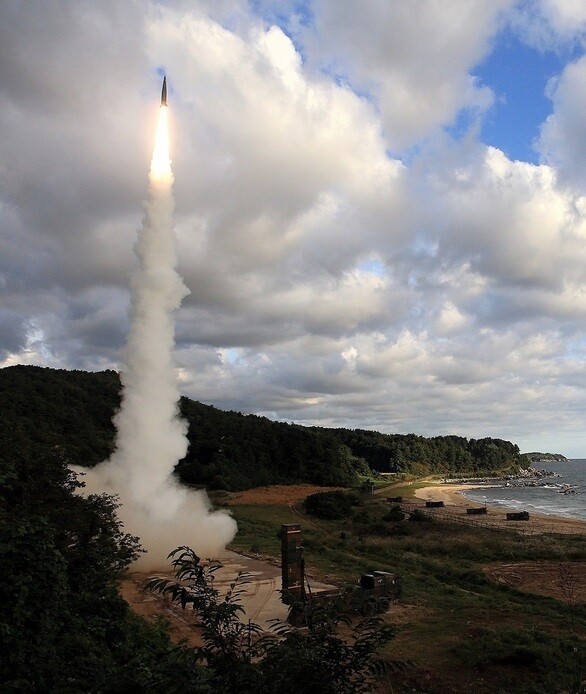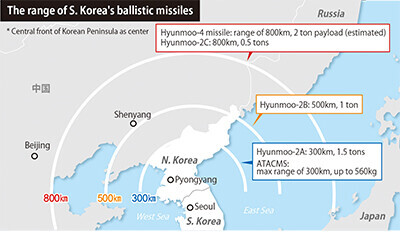hankyoreh
Links to other country sites 다른 나라 사이트 링크
Biden, Moon terminate missile guidelines for S. Korea

South Korean President Moon Jae-in announced Friday that South Korea had decided to terminate its missile guidelines following deliberations with the US and that he and US President Joe Biden had confirmed that decision in their summit.
That removes limitations on South Korea's missile sovereignty that had been in place for 43 years since 1979. The decision will likely prove to be a double-edged sword for South Korea, given the Korean Peninsula's position on the front lines of conflict between the US and China.
The decision to terminate the guidelines is significant because it restores South Korea's sovereignty over the missiles that all countries naturally seek to possess. The missile guidelines were one of three areas tied to national security over which Moon has actively sought to restore South Korean sovereignty.
The other two are regaining wartime operational control (OPCON) of the South Korean military and seeking to build nuclear-powered submarines, which will require revising South Korea and the US's agreement on the civil use of atomic energy.
The missile guidelines were instituted in September 1979, when the South Korean government announced it would limit missiles to a range of 180 kilometers and a payload of 500 kilograms. The guidelines have been revised four times since then, twice during the Moon administration, while the latest announcement terminates them completely.
"Given the practical impossibility of completing the OPCON transfer during Moon's presidency, the Biden administration appears to have done Moon a favor by terminating the missile guidelines," said an expert in foreign policy and national security.
A senior official in the South Korean government described the decision to scrap the guidelines as the "biggest achievement of the president's visit to the US."
But the fact is that the strategic ramifications of terminating the guidelines are more dubious. Previous revisions of the guidelines had capped the range of South Korea's ballistic missiles at 800 kilometers, long enough to strike anywhere in North Korea from Daegu and other sites in the southern portion of the country.
It will inevitably be assumed that the restriction was lifted to enable South Korea to target other threats than North Korea — namely, China. South Korea's other neighbor, Japan, doesn't possess ballistic missiles according to its exclusively defense-oriented policy.
In August 2019, the US withdrew from its Intermediate-Range Nuclear Forces Treaty with Russia, which had completely banned the production, testing, and deployment of medium- and intermediate-range ballistic and cruise missiles with ranges of 500-5,500 kilometers. The US explained that it was leaving the treaty, which it had signed with the Soviet Union in December 1987, because of non-compliance by Russia and the threat posed by Chinese missiles.
In the subsequent months, then-US Defense Secretary Mark Esper repeatedly indicated that the US wanted to deploy medium- and intermediate-range missiles in the Asia-Pacific region. But instead of trying to deploy US missiles in South Korea, which would provoke a conflict several times worse than the Terminal High-Altitude Area Defense system controversy in 2016-2017, the Biden administration has opted to let Seoul upgrade its own missile capabilities.

In the fourth revision of the missile guidelines in July 2020, South Korea and the US lifted the restriction on the use of solid fuel, which had been the final barrier to South Korea launching spacecraft for civil purposes.
In their Friday joint statement, Moon and Biden said they "commit to strengthening their partnership in civil space exploration, science, and aeronautics research and will cooperate towards [South Korea] signing the Artemis Accords."
Signed in October 2020, the Artemis Accords outline the basic principles for exploration and utilization of the Moon, Mars, and other bodies in space. Currently, the US, the UK, and Japan are among just eight countries that have signed the agreement.
By Gil Yun-hyung, staff reporter
Please direct comments or questions to [english@hani.co.kr]

Editorial・opinion
![[Column] Park Geun-hye déjà vu in Yoon Suk-yeol [Column] Park Geun-hye déjà vu in Yoon Suk-yeol](https://flexible.img.hani.co.kr/flexible/normal/500/300/imgdb/original/2024/0424/651713945113788.jpg) [Column] Park Geun-hye déjà vu in Yoon Suk-yeol
[Column] Park Geun-hye déjà vu in Yoon Suk-yeol![[Editorial] New weight of N. Korea’s nuclear threats makes dialogue all the more urgent [Editorial] New weight of N. Korea’s nuclear threats makes dialogue all the more urgent](https://flexible.img.hani.co.kr/flexible/normal/500/300/imgdb/original/2024/0424/7317139454662664.jpg) [Editorial] New weight of N. Korea’s nuclear threats makes dialogue all the more urgent
[Editorial] New weight of N. Korea’s nuclear threats makes dialogue all the more urgent- [Guest essay] The real reason Korea’s new right wants to dub Rhee a founding father
- [Column] ‘Choson’: Is it time we start referring to N. Korea in its own terms?
- [Editorial] Japan’s rewriting of history with Korea has gone too far
- [Column] The president’s questionable capacity for dialogue
- [Column] Are chaebol firms just pizza pies for families to divvy up as they please?
- [Column] Has Korea, too, crossed the Rubicon on China?
- [Correspondent’s column] In Japan’s alliance with US, echoes of its past alliances with UK
- [Editorial] Does Yoon think the Korean public is wrong?
Most viewed articles
- 1‘We must say no’: Seoul defense chief on Korean, USFK involvement in hypothetical Taiwan crisis
- 2Will NewJeans end up collateral damage in internal feud at K-pop juggernaut Hybe?
- 3[Column] Park Geun-hye déjà vu in Yoon Suk-yeol
- 4Why Korea shouldn’t welcome Japan’s newly beefed up defense cooperation with US
- 5Thursday to mark start of resignations by senior doctors amid standoff with government
- 6N. Korean hackers breached 10 defense contractors in South for months, police say
- 7[Guest essay] The real reason Korea’s new right wants to dub Rhee a founding father
- 8[Column] ‘Choson’: Is it time we start referring to N. Korea in its own terms?
- 9Kim Jong-un expressed ‘satisfaction’ with nuclear counterstrike drill directed at South
- 10[Editorial] New weight of N. Korea’s nuclear threats makes dialogue all the more urgent